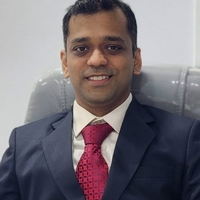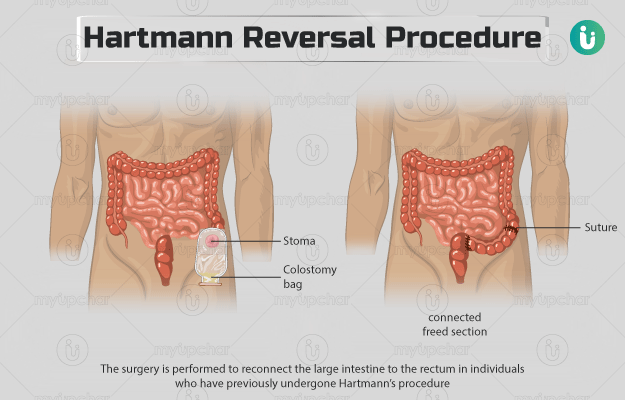Summary
Hartmann reversal procedure is performed to reconnect the large intestine to the rectum (end part of the large intestine close to the anus) in individuals who have previously undergone Hartmann’s procedure.
The surgery is conducted under general anaesthesia; you will be asleep during the procedure. The operation lasts for about 90 to 180 minutes; you will need a hospital stay for five to 10 days afterwards. Your follow-up will be scheduled six weeks after the surgery to review your progress.
- What is Hartmann reversal procedure?
- Why is Hartmann reversal procedure recommended?
- Who can and cannot get Hartmann reversal procedure?
- What preparations are needed before Hartmann reversal procedure?
- How is Hartmann reversal procedure done?
- How to care for yourself after Hartmann reversal procedure?
- What are the possible complications/risks of Hartmann reversal procedure?
- When to follow up with your doctor after Hartmann reversal procedure?
What is Hartmann reversal procedure?
Hartmann reversal procedure is done in individuals who have previously undergone Hartmann’s procedure. In Hartmann’s procedure, a portion of the large intestine is removed, the lower end that remains (rectum - the passage that ends in anus through which stool is excreted) is closed off while the upper end is pulled towards the abdominal skin to create an opening (stoma) to remove stools. Hartmann reversal procedure reconnects the cut portion of the intestine to restore its continuity and allows you to eliminate stools through the anus.
The digestive system comprises the mouth, oesophagus (food pipe), stomach, small and large intestine, rectum, and anus (back passage). Digested food passes from the small intestine to the large intestine wherein water is absorbed to create solid stools. The solid stools thus formed are stored in the rectum, and once it is full, you will get an urge to empty the bowel and pass the stool through the anus.
Hartmann’s procedure is done for the treatment of conditions that affect the intestines such as intestinal cancer. The upper end of the large intestine that is left over after Hartmann’s procedure is pulled towards the abdominal skin to create an opening (stoma) to remove stools. You will need to place a large bag over the stoma to collect stools. The lower end of the large intestine is sealed.
Hartmann reversal procedure helps to get rid of the stoma and restore the continuity of the digestive system, allowing you to pass stools through the anus. Ideally, this surgery should be done at least six months after the Hartmann’s procedure for optimal results.
Why is Hartmann reversal procedure recommended?
This procedure is recommended in people who want to remove their stoma after a Hartmann procedure.
Who can and cannot get Hartmann reversal procedure?
Factors such as the following should be considered before the surgery as they may increase the risk of complications afterwards:
- Smoking status
- High body mass index (BMI)
- Physical fitness
- Presence of sepsis
- Dyspnoea (difficulty breathing)
- Albumin levels below 3.5 U/L
- Cancer that has spread throughout the body
- Severe systemic disease (affecting the whole body) that may or may not be life-threatening
What preparations are needed before Hartmann reversal procedure?
You will need to visit the surgeon a few days before the surgery for a preoperative consultation wherein the surgeon will confirm that you are physically healthy for the procedure. Your surgeon may ask you to share the following details with him/her:
- Your medical conditions
- Allergies
- History of anaesthesia
- Whether you are pregnant
- List of medicines that you take, including herbs and over-the-counter medications
The surgeon will order the following tests:
- Blood tests
- Electrocardiogram (ECG)
- Swab test for methicillin-resistant Staphylococcus aureus (MRSA)
You will be given the following instructions to prepare for the surgery:
- Discontinue blood-thinning medicines (aspirin, ibuprofen, and warfarin) a week before the surgery.
- If you smoke, the surgeon will ask you to stop smoking.
- You will have to fast from midnight before the surgery. Fasting is recommended to prevent vomiting (risk of anaesthesia) during surgery.
- You should take a shower and remove all your body piercings, make-up, and nail polish before arriving at the hospital on the scheduled day of the surgery.
- You may be asked to empty your bowels the day before the surgery by taking a “bowel prep”. You may also be given an enema to clear your back passage.
- Arrange for a friend, family member, or responsible adult to drive you home after discharge from the hospital.
- You will have to sign an approval form to grant permission for the surgery.
How is Hartmann reversal procedure done?
After your admission to the hospital, the hospital staff will provide you with a hospital gown. They will start an intravenous (IV) line in your arm or hand to supply essential fluids and medicines during the surgery. If required, they will remove your hair around the area to be operated.
An anaesthetist will give you general anaesthesia. You may also be given epidural anaesthesia (medicine to numb the body from the waist down) before administration of general anaesthesia to control pain. Once you are asleep, a catheter (tube) will be inserted into your bladder to drain urine. The surgery will be performed by open or laparoscopic method.
Open surgery involves the following steps:
- The surgeon will make a vertical incision (cut) in your abdomen over the original incision made during the Hartmann’s procedure.
- He/she will free your large intestine from the scar tissue (adhesion) that is holding your intestines together and to the nearby abdominal organs. The surgeon will also free the sealed lower part of your large intestine.
- Next, the surgeon will make a cut around the stoma to free your large intestine from your abdominal skin.
- He/she will connect this freed section of your large intestine to your rectum with special staples or stitches.
- Finally, the surgeon will close the incisions and stoma on your abdominal skin with dissolvable stitches.
In laparoscopic surgery, the surgeon will:
- Make at least three small holes, about 1 cm wide, on your abdominal skin.
- Fill your abdomen with carbon dioxide to allow more area to operate.
- Introduce a special telescope (fitted with a camera) along with other special instruments into your abdomen through the holes.
The rest of the procedure (performed inside the abdomen) will be the same as that of open surgery.
After the surgery, the surgeon may insert a tube into the operated area to drain accumulated fluids. In some cases, a small temporary stoma may be created to allow the operated part of the intestine to heal. The surgery lasts for about 90 to 180 minutes. You may need to stay at the hospital for about five to 10 days, which may extend if you develop any complications. You can expect the following at the hospital after surgery:
- The hospital staff will move you to the intensive care unit (ICU) for close observation or directly to the recovery ward.
- Oxygen will be supplied to you through a facemask, and your vital signs will be regularly monitored.
- You will be given appropriate medicines to control pain and essential fluids will be administered to you through the IV line.
- The drain tube and catheter will be removed a few days after the surgery.
- You may receive injections daily to prevent the formation of blood clots in the legs.
- The hospital staff will encourage and assist you in getting out of the bed and walking around. This will help promote healing along with preventing blood clot formation in your legs.
- You will be taken to the regular ward once your condition is stable.
Compared to open surgery, laparoscopic surgery is associated with a shorter hospital stay, reduced postoperative pain, and minimal scarring.
How to care for yourself after Hartmann reversal procedure?
Once you reach home, you will need to take the following care:
- The surgeon will instruct you on when and how to change the dressing, if any, around the surgical site. The dressing can be replaced if it gets wet or dirty.
- He/she will prescribe medicines to help you control post-surgical pain. Antibiotics and laxatives (stool softeners) may also be prescribed to you.
- Drink a lot of water. Follow any dietary restrictions imposed by the surgeon. Eat fibre-rich foods to ease your bowel movements. Read more: How much water to drink in a day
- Resume physical activities gradually or as recommended by the surgeon. Avoid strenuous or vigorous activities for at least six weeks post-surgery.
- Avoid wearing tight clothes around your abdomen.
- You will be allowed to shower 48 hours after the surgery; however, avoid sitting in a bathtub, hot tub, or swimming until the operated area has healed completely.
- Avoid picking, pulling, or scratching the incision.
- Hold a pillow against the wound while sneezing or coughing to prevent any damage to the incision.
You may be able to resume work within six weeks, and it may take about three months to resume normal activities.
When to see the doctor?
Call or visit the surgeon if you experience any of the following after the procedure:
- High body temperature
- Increased swelling or redness around the operated site
- Increased discharge or bleeding from the incision
- Increased tiredness
- Difficulty urinating
- Severe diarrhoea or constipation
- Nausea or vomiting
What are the possible complications/risks of Hartmann reversal procedure?
The specific risks/complications associated with the surgery include:
- Anastomotic leak (leakage at the joining point of the large intestine)
- Paralysis of the large intestine
- Damage to adjacent abdominal organs
- Abnormal joining of the large intestine
- Diarrhoea
- Development of hernia
- Surgical emphysema (entrapment of air/gas under the skin)
- Chest infection
- Pain
- Bleeding
- Wound infection
- Blood clot in legs or lungs
When to follow up with your doctor after Hartmann reversal procedure?
You will have a follow-up appointment six weeks after the surgery to evaluate the healing of the operated area.
Disclaimer: The above information is provided purely from an educational point of view and is in no way a substitute for medical advice by a qualified doctor.
Find Gastroenterologist in cities
- Gastroenterologist in Gurgaon
- Gastroenterologist in Bangalore
- Gastroenterologist in Chennai
- Gastroenterologist in Jaipur
- Gastroenterologist in Ahmedabad
- Gastroenterologist in Noida
- Gastroenterologist in Mysore
- Gastroenterologist in Visakhapatnam
- Gastroenterologist in Hyderabad
- Gastroenterologist in Pune
Surgery Cost In Your City
Doctors for Hartmann Reversal Procedure

Dr. Rishabh Gupta
Gastroenterology
6 Years of Experience

Dr. Paramjeet Singh.
Gastroenterology
10 Years of Experience

Dr. Nikhil Bhangale
Gastroenterology
10 Years of Experience

Dr Jagdish Singh
Gastroenterology
12 Years of Experience
References
- Gloucestershire Hospitals [Internet]. NHS Foundation Trust. National Health Service. UK; Reversal of Hartmann's procedure
- West Suffolk: NHS Foundation Trust [Internet]. National Health Service. UK; Hartmann's procedure
- St Helens and Knowsley Teaching Hospitals [Internet]. NHS Foundation Trust. National Health Service. UK; Patient information and consent to reversal of Hartmann's operation
- Huynh H, Trottier DC, Soto CM, Moloo H, Poulin EC, Mamazza J, et al. Laparoscopic colostomy reversal after a Hartmann procedure: a prospective series, literature review and an argument against laparotomy as the primary approach. Can J Surg. 2011 Apr;54(2):133–137. PMID: 21251422.
- van de Wall BJ, Draaisma WA, Schouten ES, Broeders IA, Consten EC. Conventional and laparoscopic reversal of the Hartmann procedure: a review of literature. J Gastrointest Surg. 2010 Apr. 14 (4):743-52. PMID: 19936852.
- Cohen ME, Bilimoria KY, Ko CY, Hall BL. Development of an American College of Surgeons National Surgery Quality Improvement Program: morbidity and mortality risk calculator for colorectal surgery. J Am Coll Surg. 2009 Jun. 208 (6):1009-16. PMID: 19476884.
- Fujii T, Tsutsumi S, Matsumoto A, Fukasawa T, Tabe Y, Yajima R, et al. Thickness of subcutaneous fat as a strong risk factor for wound infections in elective colorectal surgery: impact of prediction using preoperative CT. Dig Surg. 2010. 27 (4):331-5. PMID: 20689296.
- American Society of Anesthesiologists [Internet]. Illinois. US; ASA Physical Status Classification System
- National Health Service [Internet]. UK; Having an operation (surgery)
- Hernandez A, Sherwood ER. Anesthesiology principles, pain management, and conscious sedation. In: Townsend CM Jr, Beauchamp RD, Evers BM, Mattox KL, eds. Sabiston Textbook of Surgery. 20th ed. Philadelphia, PA: Elsevier; 2017:chap 14
- Brighton and Sussex University Hospitals [Internet]. NHS Foundation Trust. National Health Service. US; Reversal of Hartmann's procedure
- Health direct [internet]. Department of Health: Australian government; Reversal of Hartmann's Procedure
- Michigan Medicine [internet]. University of Michigan. US; Instructions following abdominal surgery















